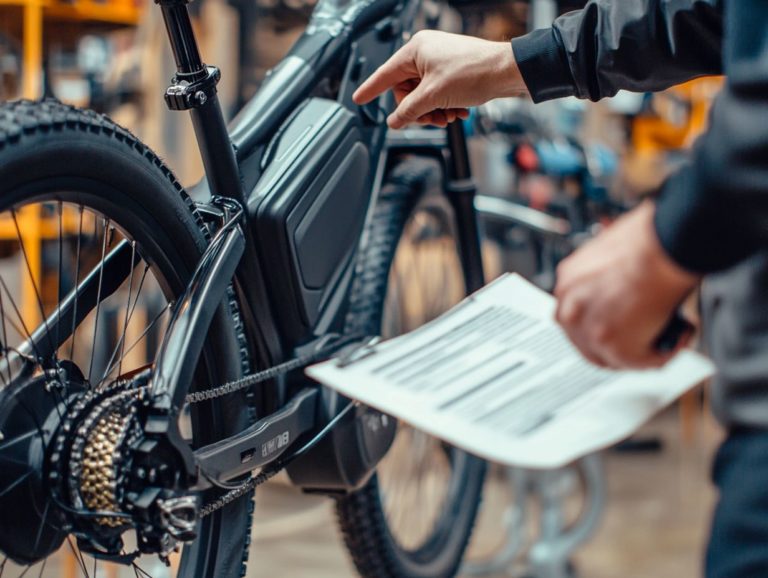Electric Bicycle Battery Disposal Regulations
Electric bicycles have become increasingly popular, making it essential for you to grasp the nuances of battery disposal.
In this exploration, you ll discover how improper disposal affects our planet and your health! You ll delve into the various types of electric bicycle batteries and the local and federal regulations that dictate their disposal.
You ll gain insight into the environmental repercussions of improper disposal, which can adversely affect ecosystems and human health.
We ll also cover proper recycling methods and alternative battery options that champion sustainability. Together, let s navigate these important topics to promote responsible electric bicycle usage.
Contents
- Key Takeaways:
- Disposal Regulations for Electric Bicycle Batteries
- Environmental Impact of Improper Disposal
- Proper Disposal Methods
- Alternative Battery Options
- Frequently Asked Questions
- 1. What are electric bicycle battery disposal regulations?
- 2. Why are there regulations for disposing of electric bicycle batteries?
- 3. Do these regulations apply to all types of electric bicycle batteries?
- 4. Are there any penalties for not following electric bicycle battery disposal regulations?
- 5. Can I dispose of electric bicycle batteries in the same way as regular household batteries?
- 6. Are there any alternative options for disposing of electric bicycle batteries?
Key Takeaways:
- Dispose of your electric bicycle batteries responsibly to protect our planet and your health!
- Local and federal regulations ensure responsible disposal of electric bicycle batteries.
- Choosing sustainable battery options can help lessen environmental impact.
Explore the Different Types of Electric Bicycle Batteries
Electric bicycles (e-bikes) depend on various types of batteries to power their performance. The most common options you’ll encounter are lithium-ion, lead-acid, and nickel-cadmium batteries.
Each type brings its own unique set of characteristics. For instance, energy density refers to how much power a battery can store in a given space. Other important factors include lifespan and maintenance requirements.
Understanding these differences is vital, as they influence not just the functionality of your e-bike, but also long-term costs and environmental considerations.
This knowledge equips you to make informed choices while contributing to sustainable urban transportation and energy efficiency.
Lithium-ion batteries are often the go-to choice for their high energy density, allowing for longer rides without the burden of extra weight. However, they do require specific charging methods and careful maintenance to keep them performing at their best.
Lead-acid batteries are more affordable, but they tend to be heavier and have a shorter lifespan, which can translate to increased maintenance needs over time. Nickel-cadmium batteries, though a bit dated in the e-bike world, offer impressive discharge rates but come with the caveat of memory effect, making careful usage essential.
Therefore, considering factors like voltage, current, and amp hours is crucial for optimizing battery performance and promoting sustainability.
Disposal Regulations for Electric Bicycle Batteries
Disposal regulations for electric bicycle batteries are essential for ensuring proper disposal and minimizing the environmental impact of these processes. As e-bike usage continues to rise, effective recycling methods have become increasingly crucial, especially for batteries containing hazardous materials like lead-acid and lithium-ion.
Regulations vary by region and typically include guidelines established by organizations such as Call2Recycle and various manufacturers. These guidelines encourage participation in collection programs.
By understanding and following these regulations, you can help mitigate environmental risks, such as the contamination of groundwater and soil.
Local and Federal Regulations
Local and federal regulations are crucial for the safe and responsible disposal of electric bicycle batteries, ensuring that harmful substances don t wreak havoc on our ecosystems. Various laws and guidelines dictate how different types of batteries, like lithium-ion and lead-acid, should be handled at the end of their lifecycle.
Compliance with these regulations often calls for collaboration among e-bike manufacturers, retailers, and you, the consumer, to foster eco-friendly practices and effective recycling methods.
As a consumer, you’ll notice that manufacturers are required to provide clear disposal instructions and recycling options, emphasizing their responsibility to educate you on proper techniques. Retailers play a significant role, acting as the vital link that facilitates the collection and safe processing of used batteries in accordance with the Resource Conservation and Recovery Act (RCRA). Additionally, being informed about electric bicycle safety regulations is crucial for responsible usage.
Local initiatives often supplement these efforts by promoting community recycling programs, making it easier for you to do your part. By adhering to these standards, everyone involved contributes to reducing environmental hazards and advancing sustainable energy solutions.
Take action today by learning more about proper battery disposal and sustainable practices!
Environmental Impact of Improper Disposal
The environmental impact of improper disposal of electric bicycle batteries is significant. It affects both local ecosystems and human health. When you discard batteries, particularly lead-acid and lithium-ion types, without care, they can release dangerous waste into the environment, contaminating groundwater and soil.
This endangers wildlife and plant life and poses risks to human health through exposure to toxic substances. Recognizing these consequences shows we need to adopt better recycling and disposal practices now!
Potential Harm to Ecosystems and Human Health
The potential harm to ecosystems and human health from improper disposal of electric bicycle batteries is substantial and demands your attention. Batteries, especially lead-acid and lithium-ion types, harbor toxic materials that can leach into the environment.
This leads to soil and water pollution. Such pollution endangers local wildlife, disrupts ecosystems, and presents health risks to individuals who may come into contact with contaminated resources.
Consider this: lead from improperly discarded batteries can seep into groundwater, jeopardizing drinking water supplies for entire communities. A study found that nearly 38% of groundwater samples in areas with inadequate battery management contained lead levels that surpassed safe drinking standards.
Lithium-ion batteries can catch fire if not handled properly, affecting air quality and posing respiratory risks. There are documented cases of declining bird populations linked to habitat degradation caused by contaminated soils from battery waste.
These examples make it clear that there is an urgent need for heightened awareness and stricter regulations regarding battery disposal methods.
Proper Disposal Methods
Understanding proper disposal methods for electric bicycle batteries is crucial in minimizing environmental impact and championing eco-friendly practices.
There are effective recycling options for different battery types, such as lead-acid, lithium-ion, and nickel-cadmium. Each necessitates specific procedures to ensure safe handling and recovery of valuable materials.
By participating in collection programs often organized by initiatives like Call2Recycle and various manufacturers you can significantly contribute to sustainability efforts while ensuring responsible battery disposal.
Recycling and Disposal Options
- Recycling options differ based on battery type, yet they all aim to minimize environmental impact.
- Organizations like Call2Recycle provide structured programs that offer accessible ways to recycle batteries safely and responsibly.
- It s crucial that you understand the specific requirements for lithium-ion, nickel-cadmium, and lead-acid batteries. Each type has unique disposal methods that deserve your attention.
- By participating in community collection events, you champion eco-conscious practices and support the recovery of valuable metals for reuse.
- Many local governments and environmental organizations have set up drop-off locations, making it easier for you to engage in responsible recycling.
By actively participating in these initiatives, you play a crucial role in contributing to the circular economy, reducing waste, and protecting the environment from toxic substances that could leach into soil and water.
Alternative Battery Options
Alternative battery options for electric bicycles are swiftly gaining momentum as you become more conscious of sustainable choices and energy efficiency.
Recent innovations in battery technology have ushered in eco-friendly alternatives that boost performance while minimizing the environmental footprint linked to traditional batteries.
By exploring options like advanced lithium-ion formulations, solid-state batteries, and even solar-powered solutions, you can make informed decisions that resonate with your sustainability aspirations.
Join local recycling events and make a difference for our planet today!
More Sustainable Choices for Electric Bicycles
Sustainable electric bicycles are capturing attention like never before! New battery technologies not only boost performance but also protect our environment.
This shift is vital for anyone wanting to make a positive impact on our planet with eco-friendly transport. Solid-state batteries improve safety and last longer, reducing waste.
The use of materials that hold a lot of energy, such as sodium-ion and graphene, can significantly extend the distance you can travel on a single charge, making e-bikes even more attractive.
Embracing these innovations helps manufacturers position their products as environmentally responsible. Companies such as APTIM and Redwood Materials are stepping up to make a difference!
Frequently Asked Questions
1. What are electric bicycle battery disposal regulations?
Electric bicycle battery disposal regulations refer to laws and guidelines that govern the safe disposal and recycling of batteries used in electric bicycles.
2. Why are there regulations for disposing of electric bicycle batteries?
These regulations protect the environment and public health, as electric bicycle batteries contain hazardous materials like cobalt and graphite, which can be harmful if not handled properly.
3. Do these regulations apply to all types of electric bicycle batteries?
Yes, these regulations cover all types of electric bicycle batteries, including lithium-ion, nickel-metal hydride, and lead-acid batteries, as well as newer technologies emerging from the 2020-2030 timeframe.
4. Are there any penalties for not following electric bicycle battery disposal regulations?
Yes, there can be penalties for not following these regulations, including fines and legal consequences. Properly disposing of your electric bicycle batteries is crucial to avoid fines, and organizations like Call2Recycle can help with this.
5. Can I dispose of electric bicycle batteries in the same way as regular household batteries?
No, electric bicycle batteries require specific disposal methods due to their hazardous materials. It s important to check with your local government or waste management company for proper disposal options, including any programs offered by PeopleForBikes.
6. Are there any alternative options for disposing of electric bicycle batteries?
Yes, some electric bicycle manufacturers, like Specialized and REI, offer battery recycling programs where you can return your old battery for proper disposal and recycling. You can also check with local electronics recycling facilities for disposal options.





